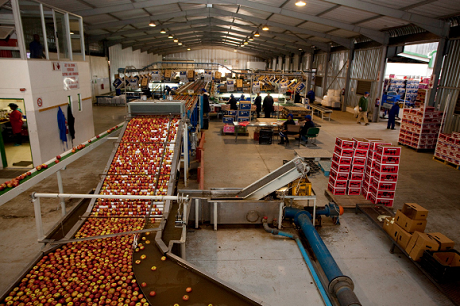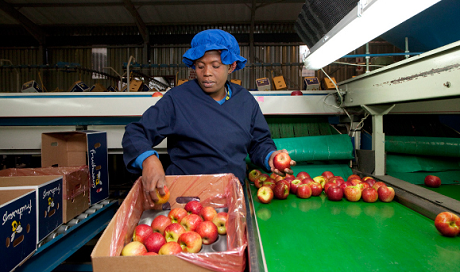The very first apples from South Africa are locally developed, heat tolerant varieties grown in Limpopo Province, but in ten to fourteen days’ time, commercially important varieties like Royal Gala will be packed in the eastern Free State, followed by red apples soon thereafter. The inland apple harvest is earlier than the Cape harvest and opens South Africa’s export campaign.

It has been a difficult run-up to the harvest, with heat wave conditions during November and December, bringing temperatures in this high-altitude, traditionally cool part of the country to the high thirties. “Such temperatures are unheard of in this part of the country. To us it feels like two doors away from hell,” quips Ryk Pretorius, apple farmer and co-director of Hi-Veld Fruit Packers. “It’s been a very difficult start to the season. The weather’s definitely been more tumultuous, typical of an El Niño year with higher temperatures, and consequently we also had a lot of hail.”
Hein Punt, of Maluti Fruit Packers, notes that the summer has been 3 to 4°C warmer than usual.
These days all productive orchards are under hail netting, which also limits sunburn. Rainfall for December 2018 has been less than half of the previous December, but recent good rain (although dam levels are still low) and current cooler weather could improve the prospects for colour development.
Coupled with the heat and hail, there were also two late cold spells, not unusual in this part of the country, but coming particularly late this year, at the beginning and again at the end of September, which affected first the flowering buds and then the flowers themselves. There are reports of some apple orchards in Mpumalanga with “small and scruffy” apples due to adverse climatic conditions.
Ryk Pretorius estimates that for the Mpumalanga apple-producing area comprising Ermelo, Amersfoort, Volksrust, Carolina and Morgenzon, fruit size could be of some concern. Hein Punt expects the coming season to be one of average fruit size for the eastern Free State, generally counts 150, 165 and 180.
The local market is empty and there is reportedly some concern among buyers regarding the quantity and quality of what’s left from last season’s cold storage apples. Currently the only fresh apples on the market are Limpopo-grown local cultivars and some very early (and sometimes very sour) Panorama Goldens from a few orchards down south.

Limp economy and weak currency make exports increasingly attractive
Royal Gala is a very popular cultivar among South African consumers, but despite the emptiness of the market there are conflicting expectations of the price points for the new harvest on the local market. Hein points to concern about the state of the local economy and the purchasing power of consumers.
“Last year we saw that packed volumes in the cold rooms didn’t move much during mid-month periods. Supermarkets can only do so much when the economy is flat, which is why we’re keeping all of our marketing channels open,” Hein says. “We’re planning to export a larger component of our harvest. We’re expanding our basket of offerings to our existing markets in the Middle East and the Far East, countries like Malaysia and Bangladesh. We’re not expecting to be sending any Royal Gala to Europe this season, as they had a good harvest with strong roll-over stocks. Some years ago we used to be packing fair quantities for the British market but they’re increasingly supplying their own needs.”
He notes that there has been an increase in the exports of red apples (like Top Red) from the eastern Free State year-on-year. Last year Cripps Pink/Pink Lady struggled due to late and excessive rain in March, but producers are hoping that their rigorous care and manipulation of the variety pays off for them this year.
